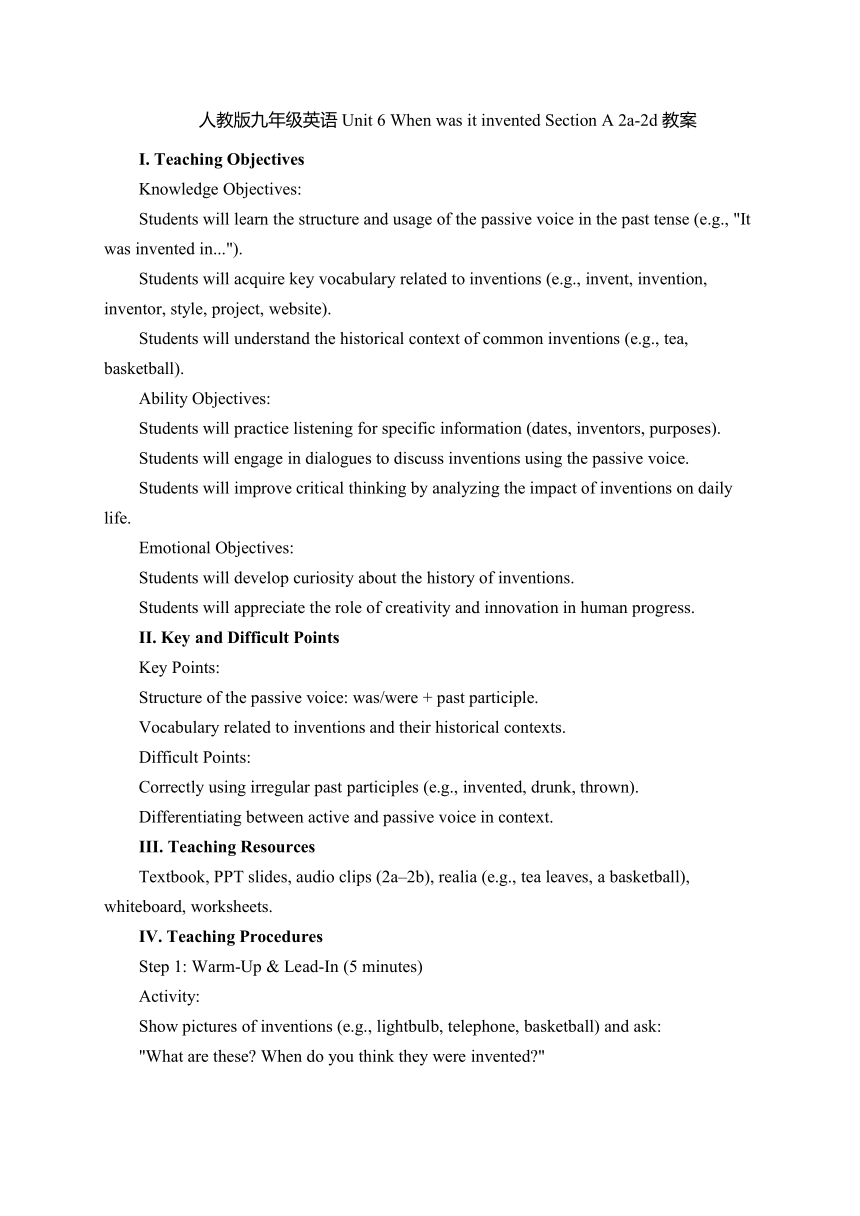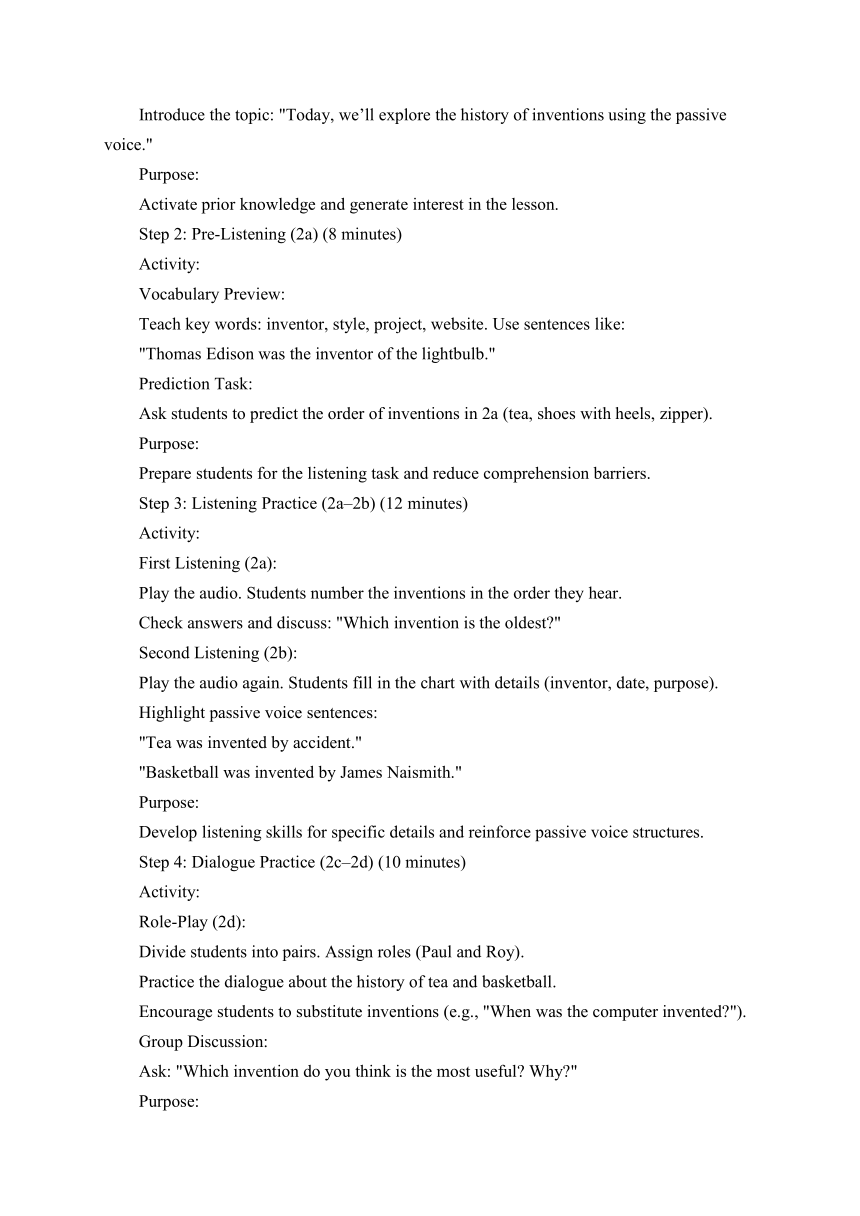人教版九年级英语Unit 6 When was it invented Section A 2a-2d教案
文档属性
| 名称 | 人教版九年级英语Unit 6 When was it invented Section A 2a-2d教案 |  | |
| 格式 | docx | ||
| 文件大小 | 15.2KB | ||
| 资源类型 | 教案 | ||
| 版本资源 | 人教新目标(Go for it)版 | ||
| 科目 | 英语 | ||
| 更新时间 | 2025-02-19 16:27:52 | ||
图片预览


文档简介
人教版九年级英语 Unit 6 When was it invented Section A 2a-2d 教案
I. Teaching Objectives
Knowledge Objectives:
Students will learn the structure and usage of the passive voice in the past tense (e.g., "It was invented in...").
Students will acquire key vocabulary related to inventions (e.g., invent, invention, inventor, style, project, website).
Students will understand the historical context of common inventions (e.g., tea, basketball).
Ability Objectives:
Students will practice listening for specific information (dates, inventors, purposes).
Students will engage in dialogues to discuss inventions using the passive voice.
Students will improve critical thinking by analyzing the impact of inventions on daily life.
Emotional Objectives:
Students will develop curiosity about the history of inventions.
Students will appreciate the role of creativity and innovation in human progress.
II. Key and Difficult Points
Key Points:
Structure of the passive voice: was/were + past participle.
Vocabulary related to inventions and their historical contexts.
Difficult Points:
Correctly using irregular past participles (e.g., invented, drunk, thrown).
Differentiating between active and passive voice in context.
III. Teaching Resources
Textbook, PPT slides, audio clips (2a–2b), realia (e.g., tea leaves, a basketball), whiteboard, worksheets.
IV. Teaching Procedures
Step 1: Warm-Up & Lead-In (5 minutes)
Activity:
Show pictures of inventions (e.g., lightbulb, telephone, basketball) and ask:
"What are these When do you think they were invented "
Introduce the topic: "Today, we’ll explore the history of inventions using the passive voice."
Purpose:
Activate prior knowledge and generate interest in the lesson.
Step 2: Pre-Listening (2a) (8 minutes)
Activity:
Vocabulary Preview:
Teach key words: inventor, style, project, website. Use sentences like:
"Thomas Edison was the inventor of the lightbulb."
Prediction Task:
Ask students to predict the order of inventions in 2a (tea, shoes with heels, zipper).
Purpose:
Prepare students for the listening task and reduce comprehension barriers.
Step 3: Listening Practice (2a–2b) (12 minutes)
Activity:
First Listening (2a):
Play the audio. Students number the inventions in the order they hear.
Check answers and discuss: "Which invention is the oldest "
Second Listening (2b):
Play the audio again. Students fill in the chart with details (inventor, date, purpose).
Highlight passive voice sentences:
"Tea was invented by accident."
"Basketball was invented by James Naismith."
Purpose:
Develop listening skills for specific details and reinforce passive voice structures.
Step 4: Dialogue Practice (2c–2d) (10 minutes)
Activity:
Role-Play (2d):
Divide students into pairs. Assign roles (Paul and Roy).
Practice the dialogue about the history of tea and basketball.
Encourage students to substitute inventions (e.g., "When was the computer invented ").
Group Discussion:
Ask: "Which invention do you think is the most useful Why "
Purpose:
Enhance speaking fluency and apply the passive voice in real-life contexts.
Step 5: Grammar Focus & Practice (8 minutes)
Activity:
Grammar Explanation:
Write examples on the board:
Active: Someone invented tea. → Passive: Tea was invented.
Highlight the structure: Subject + was/were + past participle + (by + agent).
Controlled Practice:
Distribute worksheets. Students rewrite active sentences into passive voice:
"Alexander Graham Bell invented the telephone." → "The telephone was invented by..."
Purpose:
Clarify grammar rules and ensure accurate usage.
Step 6: Summary & Homework (2 minutes)
Activity:
Recap key points: "Today, we learned how to talk about inventions using the passive voice."
Assign homework:
Write a short dialogue about an invention using the passive voice.
Complete exercises on page 45 of the workbook.
V. Teaching Reflection
This lesson aimed to introduce the passive voice through the engaging context of inventions. The warm-up activity successfully sparked students’ interest, as they eagerly shared their guesses about the origins of everyday objects. However, the listening task (2a–2b) revealed a challenge: some students struggled to catch specific dates and names due to the rapid pace of the audio. In future lessons, I will incorporate pre-listening vocabulary drills and slow down the audio for initial playbacks.
The role-play activity (2d) was a highlight, as students enjoyed dramatizing the dialogue and adding creative substitutions. However, weaker students hesitated to use irregular past participles (e.g., thrown instead of throwed). To address this, I will create a "Past Participle Bingo" game for future classes to reinforce irregular verbs in a fun way.
The grammar explanation was clear, but the worksheet practice showed that about 20% of students still confused the placement of was/were. Next time, I will use color-coded sentence strips (blue for was, red for were) to visually reinforce subject-verb agreement.
Overall, integrating realia (e.g., tea leaves) and relatable inventions (basketball) made the lesson culturally relevant. Moving forward, I will allocate more time for peer feedback during speaking activities to build confidence. The lesson achieved its objectives, but continuous reinforcement through varied activities will be essential for mastery.
I. Teaching Objectives
Knowledge Objectives:
Students will learn the structure and usage of the passive voice in the past tense (e.g., "It was invented in...").
Students will acquire key vocabulary related to inventions (e.g., invent, invention, inventor, style, project, website).
Students will understand the historical context of common inventions (e.g., tea, basketball).
Ability Objectives:
Students will practice listening for specific information (dates, inventors, purposes).
Students will engage in dialogues to discuss inventions using the passive voice.
Students will improve critical thinking by analyzing the impact of inventions on daily life.
Emotional Objectives:
Students will develop curiosity about the history of inventions.
Students will appreciate the role of creativity and innovation in human progress.
II. Key and Difficult Points
Key Points:
Structure of the passive voice: was/were + past participle.
Vocabulary related to inventions and their historical contexts.
Difficult Points:
Correctly using irregular past participles (e.g., invented, drunk, thrown).
Differentiating between active and passive voice in context.
III. Teaching Resources
Textbook, PPT slides, audio clips (2a–2b), realia (e.g., tea leaves, a basketball), whiteboard, worksheets.
IV. Teaching Procedures
Step 1: Warm-Up & Lead-In (5 minutes)
Activity:
Show pictures of inventions (e.g., lightbulb, telephone, basketball) and ask:
"What are these When do you think they were invented "
Introduce the topic: "Today, we’ll explore the history of inventions using the passive voice."
Purpose:
Activate prior knowledge and generate interest in the lesson.
Step 2: Pre-Listening (2a) (8 minutes)
Activity:
Vocabulary Preview:
Teach key words: inventor, style, project, website. Use sentences like:
"Thomas Edison was the inventor of the lightbulb."
Prediction Task:
Ask students to predict the order of inventions in 2a (tea, shoes with heels, zipper).
Purpose:
Prepare students for the listening task and reduce comprehension barriers.
Step 3: Listening Practice (2a–2b) (12 minutes)
Activity:
First Listening (2a):
Play the audio. Students number the inventions in the order they hear.
Check answers and discuss: "Which invention is the oldest "
Second Listening (2b):
Play the audio again. Students fill in the chart with details (inventor, date, purpose).
Highlight passive voice sentences:
"Tea was invented by accident."
"Basketball was invented by James Naismith."
Purpose:
Develop listening skills for specific details and reinforce passive voice structures.
Step 4: Dialogue Practice (2c–2d) (10 minutes)
Activity:
Role-Play (2d):
Divide students into pairs. Assign roles (Paul and Roy).
Practice the dialogue about the history of tea and basketball.
Encourage students to substitute inventions (e.g., "When was the computer invented ").
Group Discussion:
Ask: "Which invention do you think is the most useful Why "
Purpose:
Enhance speaking fluency and apply the passive voice in real-life contexts.
Step 5: Grammar Focus & Practice (8 minutes)
Activity:
Grammar Explanation:
Write examples on the board:
Active: Someone invented tea. → Passive: Tea was invented.
Highlight the structure: Subject + was/were + past participle + (by + agent).
Controlled Practice:
Distribute worksheets. Students rewrite active sentences into passive voice:
"Alexander Graham Bell invented the telephone." → "The telephone was invented by..."
Purpose:
Clarify grammar rules and ensure accurate usage.
Step 6: Summary & Homework (2 minutes)
Activity:
Recap key points: "Today, we learned how to talk about inventions using the passive voice."
Assign homework:
Write a short dialogue about an invention using the passive voice.
Complete exercises on page 45 of the workbook.
V. Teaching Reflection
This lesson aimed to introduce the passive voice through the engaging context of inventions. The warm-up activity successfully sparked students’ interest, as they eagerly shared their guesses about the origins of everyday objects. However, the listening task (2a–2b) revealed a challenge: some students struggled to catch specific dates and names due to the rapid pace of the audio. In future lessons, I will incorporate pre-listening vocabulary drills and slow down the audio for initial playbacks.
The role-play activity (2d) was a highlight, as students enjoyed dramatizing the dialogue and adding creative substitutions. However, weaker students hesitated to use irregular past participles (e.g., thrown instead of throwed). To address this, I will create a "Past Participle Bingo" game for future classes to reinforce irregular verbs in a fun way.
The grammar explanation was clear, but the worksheet practice showed that about 20% of students still confused the placement of was/were. Next time, I will use color-coded sentence strips (blue for was, red for were) to visually reinforce subject-verb agreement.
Overall, integrating realia (e.g., tea leaves) and relatable inventions (basketball) made the lesson culturally relevant. Moving forward, I will allocate more time for peer feedback during speaking activities to build confidence. The lesson achieved its objectives, but continuous reinforcement through varied activities will be essential for mastery.
同课章节目录
- Unit 1 How can we become good learners.
- Section A
- Section B
- Unit 2 I think that mooncakes are delicious!
- Section A
- Section B
- Unit 3 Could you please tell me where the restroom
- Section A
- Section B
- Unit 4 I used to be afraid of the dark.
- Section A
- Section B
- Unit 5 What are the shirts made of?
- Section A
- Section B
- Review of Units 1-5
- Unit 6 When was it invented?
- Section A
- Section B
- Unit 7 Teenagers should be allowed to choose their
- Section A
- Section B
- Unit 8 It must belong to Carla.
- Section A
- Section B
- Unit 9 I like music that I can dance to.
- Section A
- Section B
- Unit 10 You're supposed to shake hands.
- Section A
- Section B
- Review of Units 6-10
- Unit 11 Sad movies make me cry.
- Section A
- Section B
- Unit 12 Life is full of the unexpected
- Section A
- Section B
- Unit 13 We're trying to save the earth!
- Section A
- Section B
- Unit 14 I remember meeting all of you in Grade 7.
- Section A
- Section B
- Review of Units 11-14
